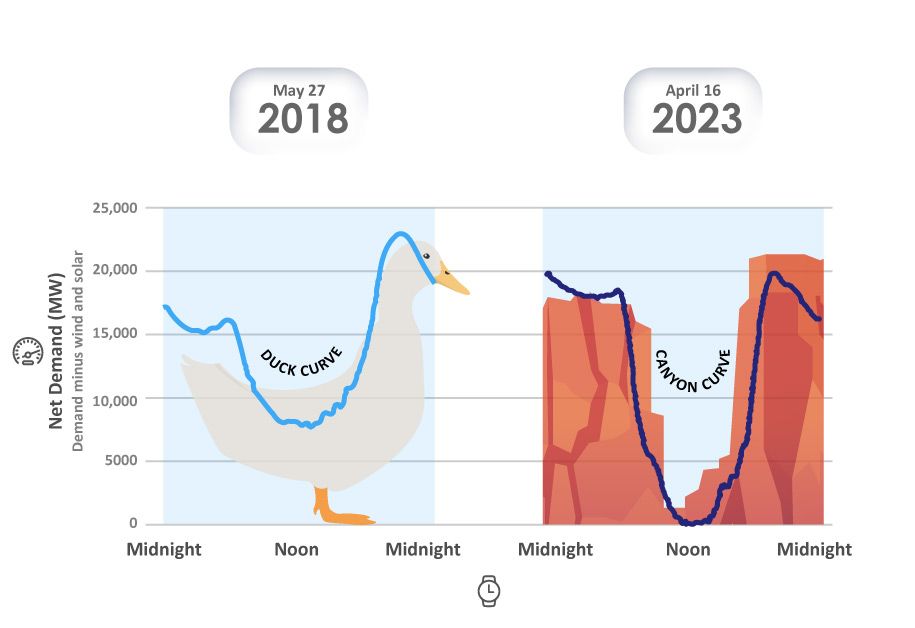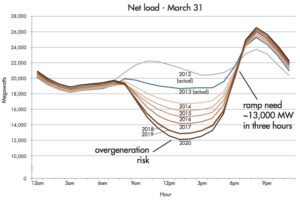EPRI Head: Duck Curve Now Looks Like a Canyon

The duck curve," a concept that has become emblematic of the challenges associated with integrating variable renewables in the power system, now looks like a canyon," illustrating a paramount urgency for adequate flexibility, Arshad Mansoor, president and CEO of the Electric Power Research Institute (EPRI), has warned.
In a recent post on LinkedIn, Mansoor highlighted changes to the duck curve," a phenomenon first unveiled by the National Renewable Energy Laboratory (NREL) in 2008 and later coined by the California Independent System Operator (CAISO) in 2013. The duck curve is essentially a 24-hour graph of the electric load met by power generation that assumes a unique shape as increasing levels of solar PV and other variable renewables are added to the system.
 The official duck chart" first published by CAISO in 2013. Source: NREL/CAISO
The official duck chart" first published by CAISO in 2013. Source: NREL/CAISOThe duck curve emphasized the challenges associated with a growing solar resource that resulted in net demand being reduced during the day (the duck's belly) and sharply increasing at sunset (the duck's neck), with both the belly getting deeper and the neck getting steeper and longer every year," Mansoor said.
While the concept has been widely adopted worldwide, it has also spurred localized iterations, such as the armadillo curve" in Texas, and the Nessie curve" in Hawaii. And while the grid operators have sought to mitigate the archetype's effect through different combinations of supply- and demand-side options, Mansoor suggested risks have been intensifying. The duck now looks like a canyon," he said.
Industry has been working to improve how the grid operates with the duck curve, since the belly can cause both over-generation issues and renewable curtailment, and the neck can make it more difficult for the resource fleet to be flexible enough to ramp up," he noted. The need for flexibility is paramount to address these challenges."
Mansoor said a canyon curve"-characterized by a deeper belly"-has now emerged. Recently, CAISO's net load has reached zero or gone negative," he noted. This has repercussions in sharply reducing dispatchable resources during the daytime. Conversely, it increases the need for flexibility as the sun sets," he said.
 The canyon is getting deeper, and this has repercussions in sharply reducing dispatchable resources during the daytime and then conversely increasing the need for flexibility as the sun sets. This is an example of the canyon curve," said EPRI's head Mansoor. Courtesy: EPRI
The canyon is getting deeper, and this has repercussions in sharply reducing dispatchable resources during the daytime and then conversely increasing the need for flexibility as the sun sets. This is an example of the canyon curve," said EPRI's head Mansoor. Courtesy: EPRIIt means that power generators will need to switch off resources that cannot turn on quickly to get out over the canyon during sunset, or else they must curtail the solar, wasting zero-cost, clean energy," he added. The canyon walls are also getting steeper, meaning energy companies need more flexibility from the reduced set of resources left," he warned.
Sharp changes to generation profiles, spurred in part by policy mandates, will have implications for managing the supply and demand balance, Mansoor suggested. Today, the descent into the canyon is done largely through reducing gas generation output, transitioning from importing to exporting power, and charging batteries," he said.
To climb the walls, some gas generation must remain online, even at the canyon floor. The full climb requires ramping up gas generation as the sun sets, exports switching to electricity imports, additional hydroelectric generation being released from reservoirs, and batteries using the energy it charged on the canyon floor, to full out discharge."
But in the future, innovative technologies may be needed to fill the canyon and scale the walls," Mansoor said. Tools include time-of-use rates and other programs that encourage electricity usage from the evening to midday. They could also include additional forms of energy storage (thermal, mechanical, chemical, etc.) that can transfer energy to when it is needed; and new technologies like hydrogen with flexible new electrolyzers," he said.
-Sonal Patelis a POWER senior associate editor (@sonalcpatel,@POWERmagazine)
The post EPRI Head: Duck Curve Now Looks Like a Canyon appeared first on POWER Magazine.